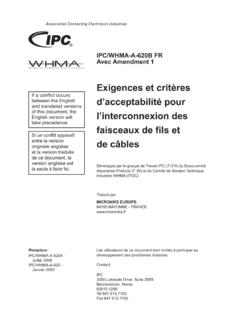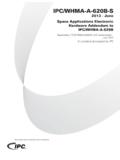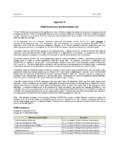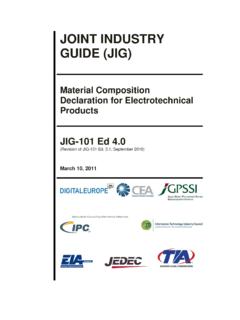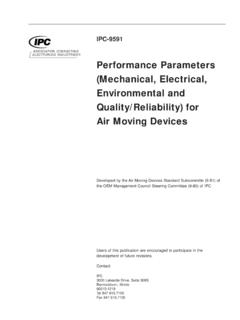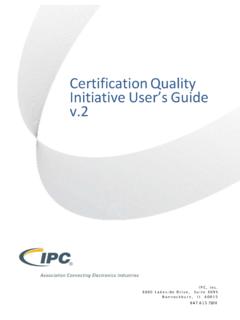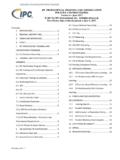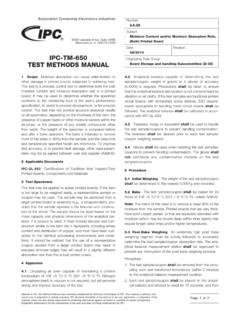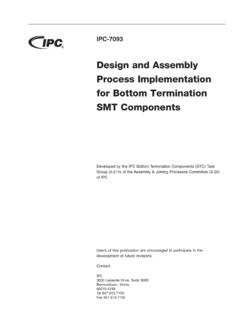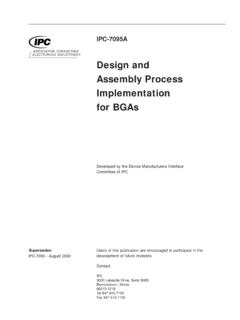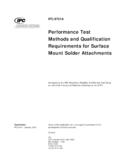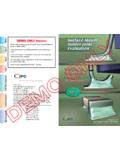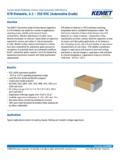Transcription of Surface Mount Placement Equipment …
1 IPC-9850 ASurface MountPlacement EquipmentCharacterizationDeveloped by the SMT Component Placement EquipmentSubcommittee (5-41) of the Assembly Equipment Committee(5-40) of IPCU sers of this publication are encouraged to participate in thedevelopment of future :IPC3000 Lakeside Drive, Suite 309 SBannockburn, Illinois60015-1249 Tel 847 847 :IPC-9850 - July 2002 Table of Contents1 .. Future .. characterization Limitations .. Binding Requirements .. Test Components .. Test Panels .. Methods .. and Definitions .. of Measurement .. 42 REFERENCED 43 Placement PERFORMANCE Performance Form IPC-9850-F1 .. General Performance .. Performance Validation .. Adding Additional Methodology .. Test Procedure .. Performance Parameters .. Work Area Test Conditions .. Throughput Results .. Accuracy Results .. 74 LINE SUMMARY FORM Station Definition # .. and Cameras.
2 Boards CB-B and CB-A andIC board IC-A .. 95 MEASUREMENT SYSTEM ANALYSIS (MSA)CAPABILITY-FORM Evaluation .. Repeatability and Measurement Procedure .. Bias .. Artifact 136 TEST Verification Panel Verification Panel CarrierSpecifications .. Slug Specifications .. Media Program .. Chip Placement Board CB-B .. Chip Placement Board IC Placement Board 177 FORMS AND 19 Appendix A Capability 23 Appendix B Specification Limits for Cpk 24 Appendix C Guidelines for Adhesive Usedfor Machine Capability Testing(Selection and Application).. 25 Appendix D Suggested Methodologies forMeasuring Components Usingan Optical 27 Appendix E Component Centroid Locationsfor Panel Population (relative tothe lower left fiducial).. 32 Appendix F Component Location for CMMV erification 39 Appendix G How to Perform a GR&R TestInstruction for Using the GaugeR&R 40 Appendix H Reliability and 42 Appendix I Placement Verification 44 Appendix J Instruction for Using 45 November 2011 IPC-9850 AvFiguresFigure 3-1 Performance Parameter Description for aFour-Panel 7 Figure 3-2 Maximum Lead Tip Error Due to PlacementMachine (Combined Xdev,Ydevand dev).
3 8 Figure 5-1 Accuracy Verification 12 Figure 6-1 Placement Verification 14 Figure 6-2 QFP 100 Slug for White Background forLeads on Chrome Background (Negative).. 15 Figure 6-3 QFP 100 Slug for Chrome Leads With NoBackground (Positive).. 16 Figure 6-4 Component Location Layout for ChipComponents - IPC-9850 PlacementVerification Panel (all dimensionsin millimeters).. 18 Figure 6-5 QFP 208 Slug for Chrome Leads With NoBackground (Positive).. 19 Figure 7-1 IPC-9850-F1 .. 20 Figure 7-2 IPC-9850-F2 .. 21 Figure 7-3 IPC-9850-F3 .. 22 Figure A-1 Cpk Graphic Representation .. 23 Figure I-1 Suggested Suitcase for PlacementVerification 44 Figure J-1 IPC-9850-MLTE 45 Figure J-2 Calculation 45 TablesTable 1-1 Component 2 Table 6-1 Tool Kit Materials List for PerformanceEvaluation Quantity Material .. 13 Table 6-2 Component Layout for Chips .. 18 Table D-1 Mean and stdev using 2 Fducials(nominal means are: x=0, y=0, theta=0).
4 28 Table D-2 Mean and stdev per method using 4 fiducials(nominal means are: x=0, y=0, theta=0).. 29 Table D-3 Mean and stdev vs. number of measuredleads (nominal means are: x=0, y=0,theta=0) .. 30 IPC-9850 ANovember 2011viSurface Mount Placement Equipment Characterization1 ScopeThis standard establishes the procedures to characterize the capability of Surface Mount assembly Equipment inspecification documents, as well as in documentation used to verify a specific machine s Placement capability and confor-mance to the specification while maintaining Placement accuracy to Placement throughput PurposeIPC-9850 has been developed to standardize the parameters, measurement procedures, and the methodolo-gies used for the specification, evaluation, and continuing verification of assembly Equipment throughput and accuracycharacterization parameters. These standardized toolsshallbe used to develop and report the information called out in BackgroundHistorically, Placement Equipment machine suppliers have selected their own parameters and methodolo-gies to present the specification of their machines throughput and accuracy capabilities.
5 The many representations of theinformation have made the comparisons between Placement machines very standard simplifies the evaluation process by coupling Placement throughput and Placement accuracy because they aredependent on each other. This standard also specifies the methodologies by which these parameters are measured. The meth-odologies specified herein are consistent and verifiable, thus providing common ground methodologies between users andmachine suppliers. The test boards used in this standard are for metrology reasons less complex than real-life boards soindividual users will experience different levels of derate depending on their products. It is recommended for evaluationpurposes that the user treats the IPC-9850 throughput rating as an initial comparison knowing that further evaluation basedon actual product would be throughput and accuracy evaluation methods of this standard specify that measurements will be made by Placement ofstandardized components into sticky media on clear glass panels.
6 Experience shows that Surface Mount Equipment must per-form well on sticky media before it can perform well in production. Furthermore, improved process capability on sticky tapeusually translates into enhanced process capability in production. Although this method does not provide all information toperfectly predict production accuracy, this methodology was selected in order to remove as much of the variation as pos-sible between facilities, products, process, and Future ConsiderationsA number of issues including but not limited to the following items were deferred to a futurerevision to this standard. Users are encouraged to provide additional recommendations and support material using the Stan-dard Improvement Form at the end of this standard: Placement density metric. Update chip component criteria (component size, C, R, shape/physical attributes) as component manufacturing technologyand use changes. For instance 0402 [01005] size components may be added in the future.
7 Develop the means to correlate the use and test results of more challenging test devices. Removing the old IPC-9850 chip board CB-A from the standard on next characterization LimitationsThis standard is comprised of a set of parameters that are the lowest common denomi-nator for Surface Mount Placement Equipment . It should be recognized that additional metrics may be of value in someinstances. The collection of parameters selected for this standard comprise the best subset for use as a core set of require-ments to be included with an Equipment supplier s general specification. This core set may change in future revisions astechnology dictates. In addition, since there are many possible combinations of hardware and software features that areunique to individual machine types, this standard cannot address every one of them. Such features and options affect theoverall capabilities of specific Equipment model and it is left to the user to understand their implications.
8 Additionally, it isincumbent upon the user to understand the restrictions and leeway provided for each parameter in this standard so the properperformance conclusions are 2011 IPC-9850A1
